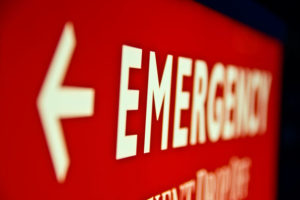October 17th, 2017
Emergency Medicine: A Life of Interruption
Alexandra Godfrey, BSc PT, MS PA-C
Emergency medicine is a life of interruption. Physicians, nurses, PAs, radiology techs, registration clerks: we are all constantly interrupted or interrupting. Unfortunately, interruptions and distractions and the consequent attention shift may lead to error. Sometimes, we fail to return to the original task, make an error in that task, or waste time on less urgent needs, neglecting critical ones.
Learning when to focus and when to ignore a distraction is perhaps one of the most vital skills needed in emergency medicine. Working in the ER can lead to a culture of immediacy; everything is now, yesterday, too late already. But seriously — is it? Just because we want something STAT, does it need to be STAT?
Recently, as part of a course in narrative medicine, I have been studying attention, awareness and mindfulness. I realized as I studied this material that not only is interruption frequent in emergency medicine, it is also widely accepted. Yes, if the patient is moribund, exsanguinating, showing tombstones on his EKG or otherwise in extremis, then interruption is essential and valid. But what about all the other times — the telephone calls, the verbal interruptions, the pages, the side conversations?
 Here are some interruptions I noticed during a recent ER shift:
Here are some interruptions I noticed during a recent ER shift:
- A clerk is on the phone. A doctor asks her to page a specialist.
- A PA is putting orders in on a patient. The triage nurse stops by and asks her to review an EKG.
- A nurse is drawing up meds to give to a patient. A PA interrupts her, asking if she will get discharge vitals on another patient.
- The physician is taking a history. The registration clerk enters the room and asks the patient for insurance information.
- The NP is reviewing imaging. The radiology tech stops by and advises him to order a creatinine on another patient.
- A physician is doing a critical procedure on a patient. A nurse walks in and asks him if she can give Zofran to another patient.
- Two physicians are doing sign-out. The social worker interrupts to discuss a psychiatric admission.
Health care systems researchers have documented interruptions in health care environments, including the relatively high interruption rate in emergency departments compared with primary care. Other evidence supports the observation that, once interrupted, ER providers frequently fail to return to the task. Moreover, attention shifts can lead to procedural errors and incomplete patient orders and evaluations.
Given these risks, could we establish protocols or an etiquette that would reduce the number of distractions and interruptions?
I think we can.
Here are some ways we might start.
First, we could each consider the import of our interruptions – i.e., ask ourselves:
- Do I need to ask this now?
- Does this need immediate attention?
 Another idea is for departments to identify critical tasks where interruption is most dangerous, such as:
Another idea is for departments to identify critical tasks where interruption is most dangerous, such as:
- Provider sign-out
- Nurse medication preparation and administration
- Patient evaluation by medical staff
- Clinician review of labs and imaging
- Putting in orders
- Patient procedures
Such tasks could be designated as protected from non-emergent interruption. ERs might also consider developing protected work stations (areas), limiting phone calls, programming EMR cues, and setting monitor alarms to safe and appropriate levels.
At the individual level, developing awareness is also a tool to mitigate distraction. Awareness requires us to be reflective and notice what does and does not interest us — and to recognize when an attention shift occurs. I am aware that being interrupted or distracted while I am putting in orders can result in a dangerous attention shift. Consequently, I consider this protected time. Unless a critical need arises, I finish these tasks first. Awareness has helped me focus my attention and avoid errors.
Being able to bring back a wandering attention — and knowing it has wandered — is one way each of us can lessen the effects of a chaotic and noisy environment. Other tools that might help are:
- List writing and post it notes
- Limiting off-topic conversations
- Limiting the number of visitors
- Posting “do not disturb” signs during critical procedures
- Limiting cell phone use by patients and their visitors
Interruption reduction is the responsibility of every member of the medical team. As both interrupters and the interrupted, I suggest we start by asking ourselves two simple questions at these moments:
Is this an appropriate time?
Should I delay this interruption?




A nice piece of literature with good points but this is business as usual in a large ER. I worked in a 100,000 plus ER and captured the same scenes and personal interruptions and judging from your youth, things , unfortunately have not changed. However I empathize with your missive because things should change as patients lives hang in the balance. In the cockpit of any major airliner when the aircraft is below ten thousand feet there are absolutely no interruptions or conversation. This is the high risk time when a plane is taking off and landing. We need to define absolutes for working in the ER and most of all; they need to be enforced.
I agree with you Robert. I don’t think much has changed. And your airplane analogy is spot on. People’s lives do hang in the balance. Of course, interruptions do need to happen at times – and should happen. But what I see is there’s no pause at all. It’s become standard to interrupt and this can lead to delays in care, safety issues and error. Call me old fashioned but I don’t think we need to speak over each other all the time or assume we can just interrupt for whatever need arises. I agree that we need to define some absolutes. Thank you for your comment. Appreciate your insight.
Tough problem. I run into this chaos where ever I encounter groups of people. Interruption seems justified to the interrupter and annoying to the interruptee. Why?
Multitasking has been glorified while listening skills have been abandoned. Interaction from electronic gadgets is progressively more intrusive.Basic manners such as not interrupting others when they are talking unless it’s an emergency are poorly taught and rarely learned.
A part of the answer is for each of us to hone our own communication skills and hopefully some of this will rub off on those who are around us.
Hi John – I totally agree with you. Multitasking has been glorified and listening (or even waiting) seems to be a long lost art. We do need to hone our communication skills. I have become much more aware of this. Interruption has become the norm. I have found a lot of the time if I just wait a couple of minutes until whoever is free then whatever it is I am asking will receive the full attention it deserves and consequently get done more efficiently (so long as during that time we don’t get interrupted again). And there is room for basic manners in medicine. This shouldn’t be forgotten. Where has that gone ? Thank you for your interesting and thoughtful response.
In the interest of full disclosure, over the years I have been both the interrupter and the interrupted. This is an interesting discussion of a problem that is not going away anytime soon. Good manners notwithstanding, the idea of having a protected spot to chart with education of staff at all levels are good starting points but may be difficult to achieve. Someone always seems to be able to track me down. Are there those here old enough to remember the “Cone of Silence”? As we all know, some interruptions in the ED are unavoidable (“Your patient in room three has started seizing.”). My problem is devising ways to avoid making errors when I return to what I was doing, or even remembering I was in the middle of something before the interruption.
George – I think many of us share your challenges. I know my most vulnerable times are when I am putting in a discharge or putting in orders. And yes – remembering to return to the task in hand after having been interrupted or disrupted is difficult. Over time, I think we get so used to interruption that we lose awareness of the constant wandering of the mind. This is (I think) when our work becomes dangerous. I hadn’t heard of the “cone of silence” so I looked it up. I think that would have made perhaps the perfect title to this piece of writing (a little satirical but spot on). Thank you for writing, George.
Multi-tasking plus instant communication equals impoliteness and errors.
Yes it does. I think that should go up on the wall behind each work station maybe.
Yes, I am old enough to remember the “Cone of Silence,” and have often used it as a mental barrier to surrounding interruptions and those talking over others. I agree that certain tasks need to be interruption-free to ensure patient safety and practitioner attention to detail. Thank you for bringing attention to this problem. I wish I could say it were limited to the ED, but I find it pervasive in medical care.
Unfortunately. I believe you are right. It is pervasive. Can you tell me more about the cone of silence? Did that have a special meaning in healthcare ?
Thank you.
Hey Alexandra: Great suggestions! Interruptions, disruptions, & external distractions are largely avoidable & a pet peeve of mine, especially as I get older. Examples: (1) Triage RN continually interrupting MD with arrival of each new patient to the POD, cue rack, & electronic tracking board. I only need to know of arrivals/pending EMS arrivals of ^*critical*^ patients, not anything else. I don’t need to know about every mundane presentation; just quietly place the chart in the rack & don’t say a word; (2) Triage RN or RN assigned to a given room interrupting to ask if they can place patient X at the head of the line because it is such a (supposedly) “quick” eval. No. See #1; (3) Retail pharmacy calling in for Rx clarification. HUC to take message & I will return call when I reasonably can; (4) Local MD calling in to send patient to ED & wants to speak to physician; People in hell want ice water; Triage RN to take detailed notes & place in patient’s chart upon arrival: (5) Nervous Nellie experienced ED RN keeps interrupting to give updates on non-critical patient. Spare me for God’s sake! Get real; (6) CT Rad Tech calling to see if OK to use IV contrast in patient with borderline serum creatinine and GFR; usually yes, just bolus with IVF before & after scan. Ask the Rad; (7) RNs not willing to take some heat for order clarification & changing it if needed in EMR w/out asking MD, SIMPLY BECAUSE they “don’t want to risk their nursing license.” They dodge 90% of the time (nurse dependent) whereas Physicians take heat for decisions almost all of the time out of restraints of time-demand necessity. If RN is afraid of the reality of the ED, do us all a favor & LEAVE: (8) Hospitalists & Sub-specialty Consultants not taking a phone call from EDP/ED-APP real time when the call is made & the case is fresh in our mind vs. some non-valid half-baked excuse for INTERRUPTING via calling back {inappropriately, inexcusably MUCH} LATER. This is incredibly disruptive to the EDP/APP, not to mention extremely rude of the Consultant. Hospitalists & Proceduralists ^may^ be given a little slack but not much. Their APP should handle the call real time: (9) EMT Paramedics are unnecessarily noisy and boisterous even with non-acute patients. Yeah, a just-arriving code is noisy as would be expected; (10) Many, many others TNTM!
Alexandra,
Thank you for your insightful piece.
Truer words were never spoken. These constant ED interruptions must lead to more errors: writing orders on the wrong patient, forgetting something important one was already taking care of, or simply becoming much less efficient. And the cacophony may also take a toll in stress and job dissatisfaction.
A previous respondent may be right: it might not be possible to “cure” this with improvement in etiquette. Another writer writes of an “information manager nurse” at the practitioner’s side. This would likely be successful, but it is hardly cost effective. Perhaps one could use an experienced scribe. Or perhaps a technological solution will appear on the horizon.
There is no doubt, however. You have hit on the Achilles heel of this otherwise amazing specialty which provides half of America’s health care!